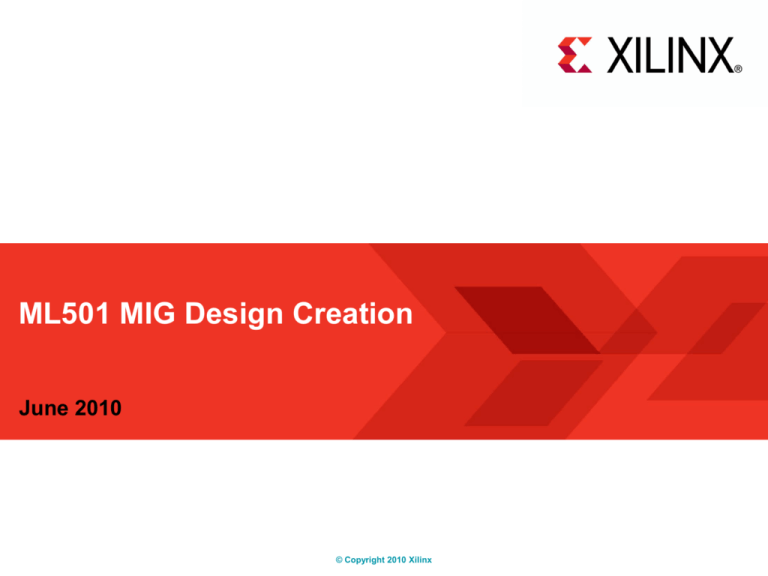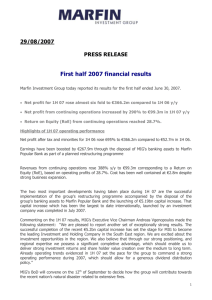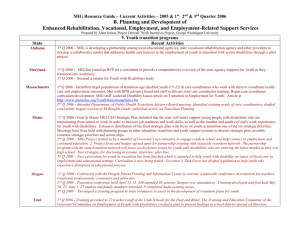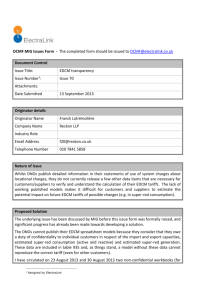ML501 MIG Design Creation
advertisement

ML501 MIG Design Creation June 2010 © Copyright 2010 Xilinx Overview Hardware Setup Software Requirements CORE Generator™ software – Memory Interface Generator (MIG) Modify Design – Add ChipScope Pro Cores to Design Compile and Test Memory Interface Appendix References Note: This presentation applies to the ML501 Virtex-5 DDR2 Capabilities MIG DDR2 SDRAM design supports frequencies up to 333 MHz in a -3 speed grade device – The MIG user guide addresses MIG performance across device speed grades The ML501 ships with a –1 speed grade device – See the Virtex-5 Datasheet for a list of Virtex-5 supported memory interface speeds – MIG DDR2 SODIMM interface design built for 266 MHz operation • Maximum SODIMM memory interface frequency Note: Presentation applies to the ML501 Xilinx ML501 Board Note: Presentation applies to the ML501 Additional Setup Details Refer to ml501_overview_setup.ppt for details on: – Software Requirements – ML501 Board Setup – Equipment and Cables – Software – Network Terminal Programs – This presentation requires the 9600-8-N-1 Baud terminal setup Note: Presentation applies to the ML501 ISE Software Requirements Xilinx ISE 12.1 software Note: Presentation applies to the ML501 ChipScope Pro Software Requirement Xilinx ChipScope Pro 12.1 software Note: Presentation applies to the ML501 Hardware Setup Connect the Xilinx Platform Cable USB to the ML501 board Optional - Pancake Fan – The ML501 will become warm during MIG testing – Recommended for keeping the Virtex-5 device cool Note: Presentation applies to the ML501 Hardware Setup MIG DDR2 SODIMM interface design built for 266 MHz operation Memory Clock via SMA Cable – Using on-board frequency synthesizer – Using user supplied external oscillator (See Appendix) SMA Cable – www.flrst.com – P/N: ASPI-024-ASPI-S402 Note: Presentation applies to the ML501 Hardware Setup An external differential clock source is required for this design Connect the clock source to J10/11 Note: Presentation applies to the ML501 CORE Generator Open the CORE Generator Start → All Programs → Xilinx ISE Design Suite 12.1 → ISE → Accessories → CORE Generator Create a new project; select File → New Project Note: Presentation applies to the ML501 Generate MIG Core Create a project directory: ml501_mig_design Name the project: ml501_mig_design. cgp Set the Part (as shipped on the ML501): – Family: Virtex5 – Device: xc5vlx50 – Package: ff676 – Speed Grade: -1 Note: Presentation applies to the ML501 Generate MIG Core Select Generation Set the Design Entry to Verilog Click OK Note: Presentation applies to the ML501 Generate MIG Core Right click on MIG Version 3.4 – Select Customize and Generate Note: Presentation applies to the ML501 Generate MIG Core Leave this page as is – Click Next Generate MIG Core Leave this page as is – Click Next Generate MIG Core Leave this page as is – Click Next Generate MIG Core Select DDR2 SDRAM – Click Next Generate MIG Core MIG defaults to a maximum frequency of 266 for a Virtex-5 –1 speed grade selection – See UG086 Make the following settings: – Set the Memory Type to SODIMMs – Set the Memory part to MT4HTF3264HY-53E Click Next Generate MIG Core Leave this page as is – Click Next Generate MIG Core Leave this page as is – Click Next Generate MIG Core Leave this page as is – Click Next Generate MIG Core Select New Design – Click Next Generate MIG Core Leave this page as is – Click Next Generate MIG Core Leave this page as is – Click Next Generate MIG Core Accept Simulation license, if desired – Otherwise, Decline license – Click Next Generate MIG Core Leave this page as is – Click Next Generate MIG Core Leave this page as is – Click Generate Generate MIG Core After the MIG core finishes generating, click OK on the Datasheet window Note: Presentation applies to the ML501 Generate MIG Core MIG core appears in Project IP Note: Presentation applies to the ML501 Design Modifications Add overlay files – ML50x specific UCF file as per AR29313 – Pre-compiled ChipScope Pro design files used to validate the design Modify top level Verilog file – Support for ML50x Board as per AR29313 – Add ChipScope Pro to design Note: Presentation applies to the ML501 Add Design Files Unzip the ml501_mig_design_overlay.zip file – Unzip to the ml501_mig_design directory – See ChipScope Pro documentation for details on generating/instantiating the ICON and ILA cores Note: Presentation applies to the ML501 Add ChipScope Pro Cores Add these lines to the top-level Verilog file (mig_v3_4.v): wire [35:0] control; wire [71:0] data; wire [7:0] trig0; Note: Presentation applies to the ML501 Add ChipScope Pro Cores Add these lines to the top-level Verilog file before endmodule: icon i_icon ( .CONTROL0(control) ); ila i_ila ( .CLK(clk0), .CONTROL(control), .TRIG0(trig0), .DATA(data) ); assign assign assign assign assign assign assign assign assign assign assign assign assign assign assign assign assign data[63:0] data[64] data[65] data[66] data[67] data[68] data[69] data[70] data[71] trig0[0] trig0[1] trig0[2] trig0[3] trig0[4] trig0[5] trig0[6] trig0[7] = = = = = = = = = = = = = = = = = app_af_addr; app_wdf_afull; app_af_afull; app_wdf_wren; app_af_cmd; phy_init_done; idelay_ctrl_rdy; sys_rst_n; error; phy_init_done; idelay_ctrl_rdy; sys_rst_n; error; app_wdf_afull; app_af_afull; app_wdf_wren; app_af_cmd; Add ChipScope Pro Cores Add these lines to the top-level Verilog file after endmodule: module icon ( CONTROL0 ); inout [35 : 0] CONTROL0; endmodule module ila ( CLK, CONTROL, TRIG0, DATA ); input CLK; inout [35 : 0] CONTROL; input [7 : 0] TRIG0; input [71 : 0] DATA; endmodule Note: Presentation applies to the ML501 Generate Bitstream Start a windows command shell and enter these commands: cd ml501_mig_design\mig_v3_4\example_design\par ise_flow.bat Note: Presentation applies to the ML501 ChipScope Pro Setup After the design compiles, open ChipScope Pro Analyzer – Click on the Open Cable Button (1) – Click OK (2) 1 2 Note: Presentation applies to the ML501 ChipScope Pro Setup Select Device → DEV:3 MyDevice3 (XC5VLX50) → Configure… Select <Design Path>\mig_v3_4\example_design\par\ mig_v3_4.bit ChipScope Pro Setup Select File → Open Project… Select <Design Path>\ready_for_download\chipscope.cpj Note: Presentation applies to the ML501 Run MIG Click on Trigger Setup to view trigger settings The error bit value should be set to 1 Note: Presentation applies to the ML501 Run MIG Click on Waveform; click the Arm Trigger button (1) Detection of an error will cause ChipScope Pro to trigger 1 Note: Presentation applies to the ML501 Run MIG To force a trigger, in order to view the waveform, click the T! button (1) 1 Note: Presentation applies to the ML501 ML501 DDR2 Verification Virtex-5 –1 speed grade device supports 266 MHz DDR2 operation as stated in the Virtex-5 datasheet The ML501 SODIMM supports 266 MHz – Supplied DDR2 SODIMM is rated for 266 MHz operation The MIG test design and ChipScope Pro Analyzer verify operation of the ML501 with a Virtex-5 –1 speed grade device, with a memory clock of 200 MHz using the on-board frequency synthesizer See appendix for 266 MHz operation with user supplied oscillator Note: Presentation applies to the ML501 Appendix ML501 DDR2 at 266 MHz An external signal generator was used to clock the MIG test design on the ML501 at the maximum clock rate selectable in the MIG tool, 266 MHz Supplied DDR2 SODIMM is rated for 266 MHz operation The MIG test design and ChipScope Pro Analyzer verify operation of the ML501 at the maximum selectable MIG clock rate of 266 MHz for a -1 speed grade device – See UG086 Note: Presentation applies to the ML501 References Documentation Memory Solutions – Demos on Demand – Memory Interface Solutions with Xilinx FPGAs http://www.demosondemand.com/clients/xilinx/001/page_new2/index.asp#35 – Xilinx Memory Corner http://www.xilinx.com/products/design_resources/mem_corner – Additional Memory Resources http://www.xilinx.com/support/software/memory/protected/index.htm – Xilinx Memory Interface Generator (MIG) User Guide http://www.xilinx.com/support/documentation/ip_documentation/ug086.pdf References Virtex-5 – Virtex-5 FPGA Family http://www.xilinx.com/products/virtex5/index.htm ChipScope Pro – ChipScope Pro Software and Cores User Guide http://www.xilinx.com/support/documentation/sw_manuals/ xilinx12_1/chipscope_pro_sw_cores_ug029.pdf Documentation Documentation ML501 Documentation – ML501 Overview http://www.xilinx.com/ml501 – ML501 Evaluation Platform User Guide – UG226 http://www.xilinx.com/support/documentation/boards_and_kits/ug226.pdf – ML501 Getting Started Tutorial – UG228 http://www.xilinx.com/support/documentation/boards_and_kits/ug228.pdf – ML501 Reference Design User Guide – UG227 http://www.xilinx.com/support/documentation/boards_and_kits/ug227.pdf










